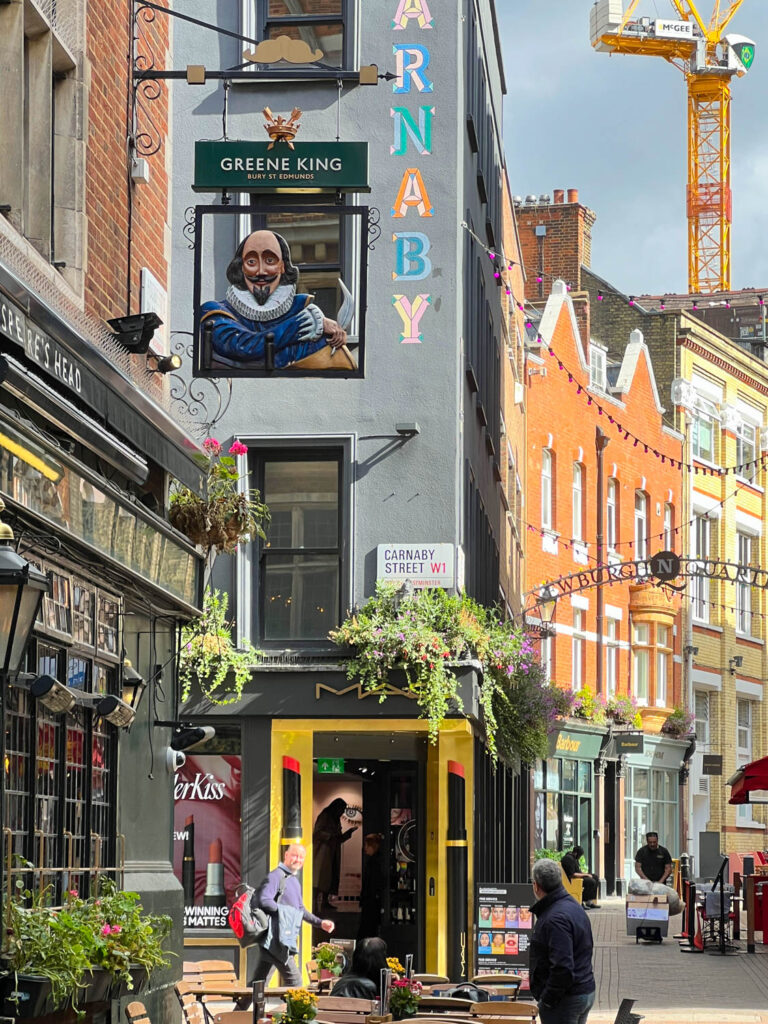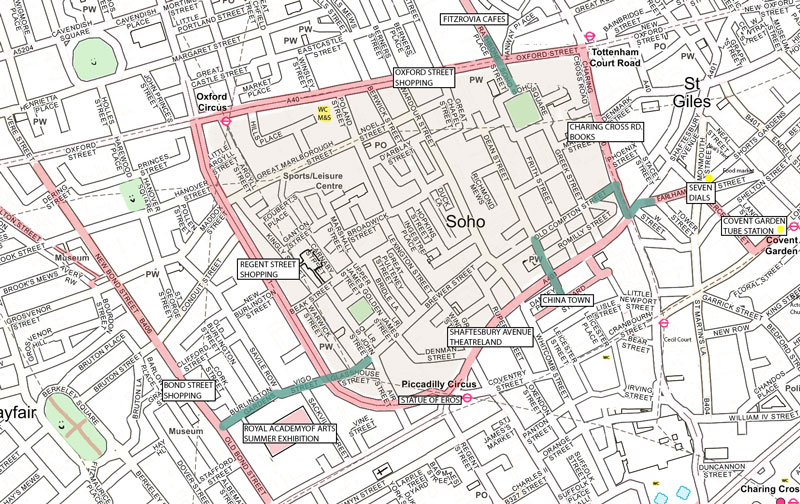
Visiting Soho
Soho retains its 17th century layout and with its narrow streets is an areas where you really can just wander without a map. Stick to the red streets for the best experience.

Soho is famous for its nightclubs, music venues, clubs and pubs, its restaurants, its gay scene, tolerance, cosmopolitanism and celebrity. Carnaby Street and surrounding streets were once at the centre of fashion and music in 60’s “Swinging London”. Old Compton and Brewer Streets were London’s red light district before a general gentrification in the area in recent times.

Highlights
- Nightlife. There are countless well known establishments, many of them with with fascinating histories, and many with associations with the early careers of artists like the Rolling Stones, David Bowie, Pink Floyd, the Sex Pistols, leading jazz musicians ….. Private clubs like Soho house attract stars of film and media.
- Carnaby Street and surrounding alleys are no longer cutting edge fashion, but retain their liveliness and bustle. The back entrance of Liberty’s luxury department store is at the top of Kingly Street. There is an attractive courtyard full of eateries which can be accessed by little alleys off Carnaby Street, Beak Street or Kingly Street.
- Laid back Soho Square with its distinctive black and white cottage and surrounding grass and benches full of sunbathers in summer. Secluded Golden Square is also a calm oasis.
- Berwick Street food market, a market site since the 17th century.
- Chinatown
- There’s not really that much here for younger children unless they like little cafes and shops. They will be able to run about on the squares. Brewer Street and Old Compton Road still have a few ‘adult’ shops around Wardour Street.
- There are toilets in Marks and Spenser, Oxford Street, where it meets Poland Street and public toilets on Leicester Square.

Connections

Soho has great connections and is a short walk from Piccadilly Circus. Walk west for designer shopping on elegant Regent Street, and beyond that more luxury shopping on Bond Street in Mayfair. The Royal Academy is close by. Walk north for shopping on Oxford Street. If you walk north from Soho Square and cross Oxford Street you will enter the trendy little area of Fitzrovia with its cafes. Shaftesbury Avenue to the south is rather busy with traffic, but is strongly associated with the theatre. Cross over and you will be beneath the lanterns of vibrant Chinatown and beyond that Leicester Square. Charing Cross Road to the East is well known for booksellers. If you cross it you will be in Covent Garden.





History
- Established as an early suburb of London in 1600s after the Great Fire, the area has a tradition for tolerance, egalitarianism and cosmopolitanism, welcoming refugees throughout its history, at one time being likened to a little Paris following an influx of Hugenots and refugees from the French Revolution.
- Although originally built to attract the rich, by the 19th century the area was one of the most densely populated in London, shabby and poverty-stricken. It is only relatively recently that it has experienced a reverse process of gentrification and astronomical property prices.
- The Jon Snow pub on 39 Broadwick Street is built on the site of Jon Snow’s surgery. He was one of the first doctors to use anaesthetics, administering chloroform to Queen Victoria, and is famously credited with noticing the connection between a polluted public water pump nearby and a local cholera epidemic in the 1850s (cholera was then thought to be airborne). He noticed that workers who drank beer rather than water were not coming down with the sickness. The raised churchyard of St Anne’s church off Wardour Street was a former burial ground for cholera victims.
- During the Second World War, the Dutch resistance met at De Hems pub in Chinatown. De Gaulle conducted the French resistance from French House, a pub on Dean Street.
- Briefly in 60’s and again in late 70’s “swinging London” centred on Carnaby Street and was most fashionable in the Western world.
- In 1970s Bewick Street and Old Compton Street were a notorious red light district, but sex shops now have to be licensed leading to that industry’s decline.

Walk

Walk Description
Starting at Piccadilly Circus tube station, walk up Air Street and on into St John Street passing Golden square on your right. You will reach Beak Street. Straight ahead of you is a small entrance leading to an attractive multi-level restaurant courtyard. walk through and exit again on your left into Kingly Street. Turn right and take second right into Floubert’s Place. Carnaby Street is now on your right. I have suggested weaving between parallel Flauberts Place and Carnaby Street. At the end of Carnaby Street turn left into Beak Street, then left at Lexington Street, then right into Broadwick Street. Go to the end and you will see the narrow Bewick Market to your right. Walk down the market and before the archway turn left then left again into Wardour Street. Cross the street and enter Meard Street straight ahead. Turn left then right into Frith Street and walk up to Soho Square. Turn right on the square then go down Greek Street on your right. At the bottom you will meet Old Compton Street. Turn right, then left into Dean Street. You will see the Chinese gate and lanterns of China Town ahead of you. Cross Shaftesbury Avenue and walk down through the gate into Gerrard Street. Turn left, right, right, right then left into a small alley Rupert Court which will bring you out in Rupert Street. Turn left, cross Shaftesbury Avenue and turn left into Brewer Street. Second left into Sherwood Street will bring you back to Piccadilly Circus.